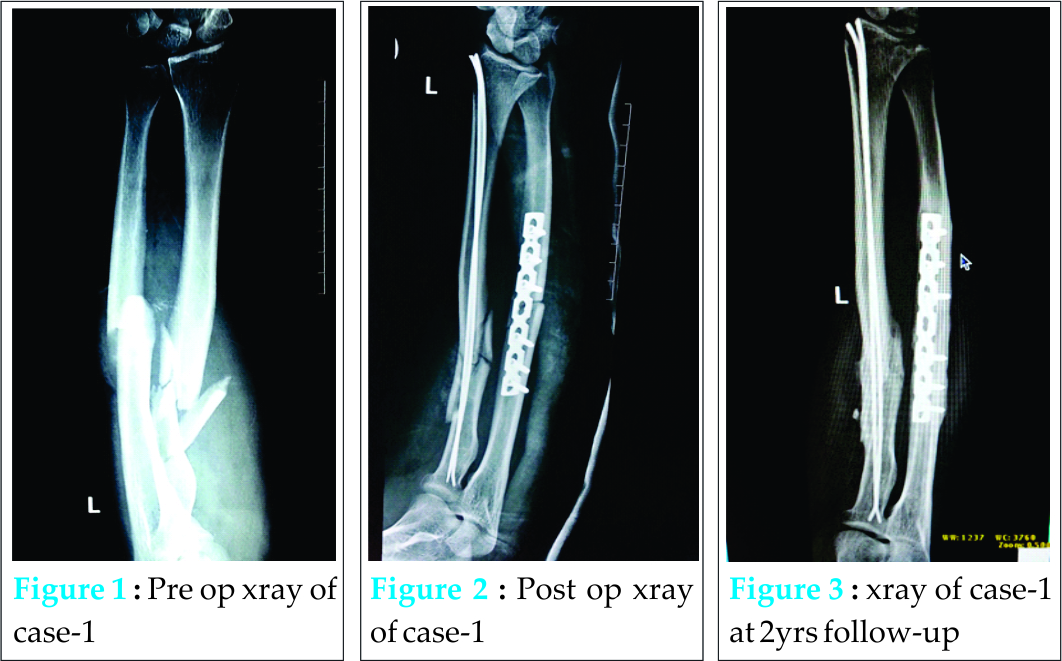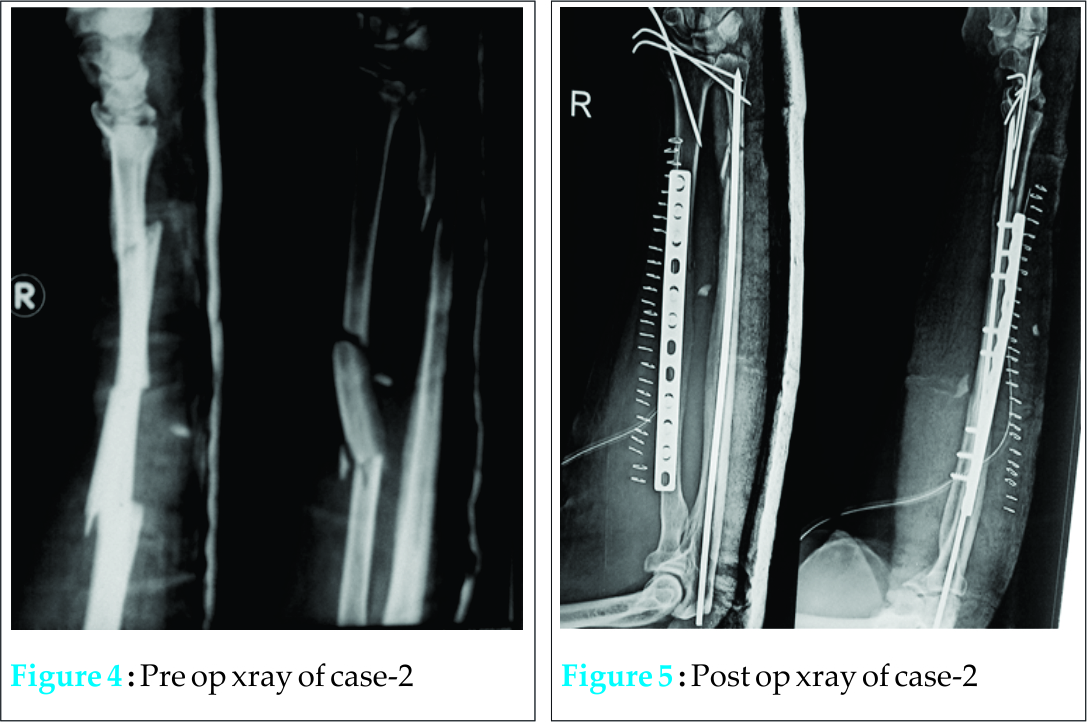[box type=”bio”] What to Learn from this Article?[/box]
These two cases are kind of rare presentations, having excellent outcome with the operative treatment mentioned. The learning task from the article is to get awareness of such a complex fracture presentation and its management to achieve satisfactory results.
Case Report | Volume 5 | Issue 3 | JOCR July-Sep 2015 | Page 22-24 | Harsh Raval1, J.B. Panse, Prakash Amin, Jyotindra Pandit. DOI: 10.13107/jocr.2250-0685.298.
Authors: Harsh Raval[1], J.B. Panse[1], Prakash Amin[2], Jyotindra Pandit[2].
[1] Department of Orthopaedics, Inlaks & Budhrani Hospital,Pune, Maharashtra, India.
[2] Department of Orthopaedics, HarikrupaOrthopaedic Hospital, Ellisbridge, Ahmedabad, Gujarat, India
Address of Correspondence
Dr. Harsh Raval,
Department of Orthopaedics, Inlaks & Budhrani Hospital, 7-9, Lane-01, Koregaon park, Opp.Osho International Centre, Koregaon park, Pune- 411001. India.
E-mail: drharshraval@yahoo.com
Abstract
Introduction: Diaphyseal fractures of both bones of the forearm are commonly encountered in clinical practice. Segmental radius shaft fractures are, however, less commonly seen. We hereby report two cases of segmental complex radius fracture with mid-shaft ulna fracture. Such type of cases are reported previously in children but rarely in adults.
Case Report: In case-1, comminuted radius shaft fracture was fixed with square nails and ulna was fixed with Recon plate. In case-2, plating was done for radius mid-shaft, K-wiring for distal radius, and ulna was stabilized with a square nail. Details of both cases aredescribed and alternative management options are discussed.
Conclusion: To the best of our knowledge, a segmental fracture of the radius associated with ipsilateral mid-shaft fracture of the ulna in an adult has been rarely reported in the literature to date. Optimal management of such fracture configuration has not been outlined in the literature. Prompt surgical management of such a complex fracture resulted in a rapid,full and satisfactory functional recovery for our patient.
Keywords: Segmental radius diaphyseal fracture, Square nail, Bone graft.
Introduction
Diaphyseal fractures of both bones of the forearm are commonly encountered in clinical practice. Segmental radius shaft fractures are, however, less commonly seen. We hereby report two cases of segmental complex radius fracture with mid-shaft ulna fracture. Such type of cases are reported previously in children but rarely in adults.
Case report
Case 1
A 35-year-old, right dominant handed man, involved in road traffic accident while driving two wheeler had sustained injury to left forearm, resulting in obvious clinical deformity. No neurovascular deficit was evident. Radiograph revealed comminuted, multifocal radial shaft fracture in combination with displaced two part diaphyseal fracture of the ulna(Fig. 1). Within 24 h, an open reduction and internal fixation of the fracture was performed. Under general anesthesia, using a direct subcutaneous approach to the ulna, the ulna was reduced and fixed with a seven-holed Recon plate. The radius was exposed through Henry’s approach[1], manual reduction was achieved and two square nails were passed retrograde. Careful handling of the soft tissues was paramount and extra care was taken to avoid devascularization ofany of the bone fracture segments. The decision for squarenails was taken because of commination. Incision length for ulna was 8 cm and for radius 5 cm.After wound closure, an above-elbow back slab wasapplied with the elbow held in 90° of flexion.The forearm was held elevated in a sling and our patientwas monitored for signs of compartment syndrome. Our patient was discharged from hospital after 48 h of observation in a broad arm sling; there were no immediate post-operative complications. Post-operativeX-ray was satisfactory(Fig. 2).
After 2 weeks, the sutures were removed. There was no neurovascular deficit. Back slab was continued for total 3 weeks from surgery and assisted a range of movements was started after suture removal.At 6 weeks follow-up, our patient showed further functional improvement. Results as seen on radiographs were satisfactory. After 3 months, our patient returned to work as an administrator. Patient was able to perform his routine activities with his left forearm without any difficulty except terminal supination and was started on physiotherapy. Patient was followed till 2 years and showed good functional and radiological outcome (Fig. 3). Our patient completed the disabilities of the arm,shoulder and hand (DASH)[2] questionnaire and scored 52.1 (measures scaled on a 0-100 scale: A higher score indicates greater disability).
Case 2
A 48-year-old female presented to emergency department after being hit by a car and had sustained injury to the dominant forearm. On examination, obvious deformity was present, no neurovascular deficits noted. She was admitted and referred to surgery. Radiograph showed a segmental fracture of mid-shaft radius with extra articularipsilateral distal radius fracture and two part lower shaft fracture of the ulna(Fig. 4).
Under general anesthesia, open reduction and fixation of radial shaft was done through Henry’s approach with 12 holes limited contact dynamic compression plate(LC-DCP), length of incision was 15 cm, close reduction and fixation done with three K-wires for distal radius. Ulna fracture reduction was performed by close manipulation and fixed with a square nail. Post-operativeback slab was given and patient was discharged on third post-operative day without any complication. Post-operative X-ray was satisfactory (Fig. 5). After2 weeks, the sutures were removed. There was no neurovascular deficit.Back slab was continued for 3 weeks with assisted range of elbow movements. At 8 weeks follow-up, our patient showed functional improvement and satisfactory radiological union. Patient was able to perform her routine household activities except weightlifting as she was housewife. This patient has scored 53.5 on the DASH questionnaire[2].
Discussion
While diaphyseal fractures of the radius and ulna are common, the trifocal diaphyseal fracture of the radius with concurrent mid-shaft ulna fracture is much less frequently encountered[3]. The AO classification system of thediaphyseal radius and ulna fractures has described complex fractures of both bones, but only bifocal injuries(that is, involving two points of fracture along a single bone)[4]. No classification system as yet has described this particular type of injury. A closed ipsilateral supracondylar humerus with the trifocal ulna and bifocal radius fractures has also been reported[5]. Intra-medullary pinning of diaphyseal fractures of both forearm bones in adults has been found to provide good outcomes, as has the use of an interlocking intra-medullary nail, with a mean union time of 15 weeks using an open reduction technique[6]. A retrospective study into 38 cases involving complexfractures of the proximal radius and ulna in adult patients treated via various methods has been performed.In this study, there were seven early revisions due to disassembly of the fixation system, deep infection, and insufficient fixation. A number of late complications arose including non-union and malalignment[7]. In cases of non-union of fractures of the radius and ulna,there is evidence to suggest that plate fixation with autologous cancellous bone grafting can result in high rates of union and improved upper limb function[8]. In case-1, the decision to put square nail for radius was taken because of the proximity of fracture, inherent comminution and to avoid soft tissue problems. Square nail was passed by maintaining the fracture fragments in alignment by traction against counter traction, which was found satisfactory intraoperatively under image guidance. Two square nails were passed to achieve stable fixation[9]. In case-2, decision to put a long LC-DCP[10] was taken as middle fragment was long enough to hold with two cortical screws. Bone grafting was deemed unnecessary in our cases as we managed to reduce the fractures anatomically, under direct compression. The radial bow and length was achieved intra-operatively in both the cases. We would advocate the use ofbone graft in such circumstances where there is marked comminution at fracture ends and where anatomic reduction cannot be achieved. In ourcases, we also believe that careful preservation of vascularity of the bone fracture segments obviated the need for bone grafting.
Conclusion
The present case reports highlight a rare combination of injuries. While such injuries occur infrequently, we should try to obtain anatomical reduction and rigid fixation to achieve the best possible functional outcome, improve the chance of fracture union and possibly reduce the incidence of post-operative complications.
Clinical Message
This report highlights a rare injury and its successful management. Prompt surgical intervention with the appropriate method of open reduction and internal fixation can lead to a good result.
Reference
1. Beaty C. Surgical approaches.Technique 1-96. Anterior approach to the distal half of the radius.Campbell’s Operative Orthopaedics. 11th ed.Philadelphia: Mosby Elsevier; 2008.
2. Hudak PL, Amadio PC, Bombardier C. Development of an upper extremity outcome measure: The DASH (disabilities of the arm, shoulder and hand) [corrected]. The upper extremity collaborative group (UECG) Am J Ind Med 1996;29(6):602-608.
3. Ibrahim M, Cwilewicz J, Khan OH, Gibbon A. Unilateral, trifocal, diaphyseal fracture of the radius with ipsilateral mid-shaft ulna fracture in an adult: A case report. J Med Case Rep 2011;5:123.
4. Heim D, Luria S, Mosheiff R, Weil Y. AO Foundation. Available from: https://www2.aofoundation.org/wps/portal/surgery.(Here is the link of reference-
https://www2.aofoundation.org/wps/portal/surgery?showPage=diagnosis&bone=Radius&segment=Shaft)
5. Ravi Mittal MS, Vijay Sharma MS. Ipsilateral supracondylar humeral andsegmental both bones forearm fracture in a child: A case report. Middle East J Emerg Med 2005;1:3.
6. Gao H, Luo CF, Zhang CQ, Shi HP, Fan CY, Zen BF. Internal fixation of diaphyseal fractures of the forearm by interlocking intramedullary nail: Short-term results in eighteen patients. J Orthop Trauma 2005;19(6):384-391.
7. Chick G, Court C, Nordin JY. Complex fractures of the proximal end of the radius and ulna in adults: A retrospective study of 38 cases. Rev ChirOrthopReparatriceAppar Mot 2001;87(8):773-785.
8. Ring D, Allende C, Jafarnia K, Allende BT, Jupiter JB. Ununiteddiaphyseal forearm fractures with segmental defects: Plate fixation and autogenouscancellous bone-grafting. J Bone Joint Surg Am 2004;86-A(11):2440-2445.
9. Mseddi MB, Manicom O, Filippini P, Demoura A, Pidet O, Hernigou P. Intramedullary pinning of diaphyseal fractures of both forearm bones in adults: 46 cases. Rev ChirOrthopReparatriceAppar Mot 2008;94(2):160-107.
10. Leung F, Chow SP. A prospective, randomized trial comparing the limited contact dynamic compression plate with the point contact fixator for forearm fractures. J Bone Joint Surg Am 2003;85-A(12):2343-2348.
| How to Cite This Article: Raval H, Panse JB, Amin P, Pandit J. Unilateral, Multifocal Fracture of Radial with Ipsilateral Midshaft Ulna Fracture – Two Such Unusual and Rarely Reported Cases. Journal of Orthopaedic Case Reports 2015 July – Sep;5(3): 22-24. Available from: https://www.jocr.co.in/wp/2015/07/10/2250-0685-298-fulltext/ |
[Full Text HTML] [Full Text PDF] [XML]
[rate_this_page]
Dear Reader, We are very excited about New Features in JOCR. Please do let us know what you think by Clicking on the Sliding “Feedback Form” button on the <<< left of the page or sending a mail to us at editor.jocr@gmail.com







